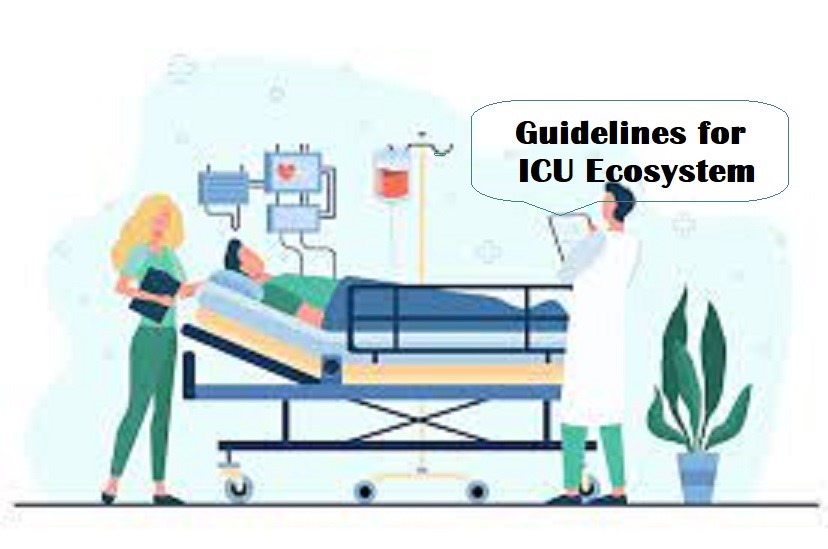Defines who is an intensivist; Consent of the patient mandatory for ICU admission

New Delhi: The Union Health Ministry for the first time has come up with guidelines for hospitals on ICU ecosystem and directed that hospitals cannot admit critically ill patients in the ICU without the consent of the patient and family. According to the latest guidelines, patients who are critically ill should not be admitted to an ICU if they do not give their consent. “Critically ill patients should not be admitted to the ICU, if Patient’s or next-of-kin informed refusal to be admitted in ICU.” The new guidelines have been developed by doctors with expertise in critical care medicine working in different levels of Hospital and Intensive Care Units across the country.
The guidelines has defined the intensivist, qualification and experience of the intensivist. The intensivist should have a postgraduate qualification in Internal Medicine, Anaesthesia, Pulmonary Medicine, Emergency Medicine, or General Surgery with either of the following “An additional qualification in Intensive Care such as DM Critical Care/Pulmonary Critical Care, DNB/FNB Critical Care (National Board of Examinations), Certificate Courses in Critical Care of the ISCCM (IDCCM and IFCCM), Post-Doctoral Fellowship in Critical Care (PDCC/Fellowship) from an NMC recognised University, or equivalent qualifications from abroad such as the American Board Certification, Australian or New Zealand Fellowship (FANZCA or FFICANZCA), UK (CCT dual recognition), or equivalent from Canada.” As far as the training is concerned, the intensivist should have either of the following “At least one-year training in a reputed ICU abroad. A few candidates of the ISCCM Certificate Course (CTCCM) who have been certified with a 3-year training programme in Intensive Care after M.B.B.S. are also recognised as Intensivists. In addition, persons so qualified or trained must have at least two-years’ experience in (at least 50% time spent in the ICU ).” it said. “In case of doctors not having either of the mentioned qualifications or training, they should have extensive experience in Intensive Care in India after M.B.B.S., quantified as at least three years’ experience in ICU (at least 50% time spent in the ICU).” stated the guidelines
The criteria for admitting a critical patient to ICU should be based on organ failure and the need for organ support or in anticipation of deterioration in the medical condition. Admission criteria should be based on altered level of consciousness and if a patient requires respiratory support, “Altered level of consciousness of recent onset; Hemodynamic instability (e.g., clinical features of shock, arrythmias); Need for respiratory support (e.g. escalating oxygen requirement, de-novo respiratory failure requiring non-invasive ventilation, invasive mechanical ventilation, etc.); Patients with severe acute (or acute-on-chronic) illness requiring intensive monitoring and/or organ support; Any medical condition or disease with anticipation of deterioration; Patients who have experienced any major intraoperative complication (e.g. cardiovascular or respiratory instability); Patients who have undergone major surgery, (e.g. thoracic, thoraco-abdominal, upper abdominal operations, trauma who require intensive monitoring or at a high risk of developing postoperative complications),” stated the guidelines.
The following critical patient should not be admitted to the ICU, “Patient or its family member refusing to admit in ICU; Any disease with a treatment limitation plan; Anyone with a living will or advanced directive against ICU care; Terminally ill patients with a medical judgment of futility; Low priority criteria in case of pandemic or disaster situation where there is resource limitation (e.g. bed, workforce, equipment).”
The ICU discharge criteria guidelines for ICU patient states, “Return of physiological aberrations to near normal or baseline status; Reasonable resolution and stability of the acute illness that necessitated ICU admission; Patient/family agrees for ICU discharge for a treatment-limiting decision or palliative care; Based on lack of benefit from aggressive care (should be a medical decision, not obligating family agreement and as far as possible should not be based on economic constraint; For infection control reasons with ensuring appropriate care of the given patient in a non ICU location; Rationing (i.e., prioritisation in the face of a resource crunch). In this event there should be an explicit and transparent written rationing policy that should be fair, consistent and reasonable.”
The minimum patient monitoring required while awaiting an ICU bed include, “Blood pressure (continuous/intermittent); Clinical monitoring (e.g., pulse rate, respiratory rate, breathing pattern etc.); Heart rate (continuous/intermittent); Oxygen saturation – SpO2 (continuous/intermittent); Capillary refill time; Urine Output (continuous/intermittent); Neurological status e.g. Glasgow coma scale (GCS), Alert verbal pain Unresponsive (AVPU) scale etc.; Intermittent temperature monitoring; Blood sugar.”
The minimum stabilisation required before transferring a patient to ICU includes “Ensuring a secure airway (i.e., tracheal intubation if the patient has a GCS <=8); Ensuring adequate oxygenation and ventilation; Stable haemodynamics, either with or without vasoactive drug infusion; Ongoing correction of hyperglycemia/hypoglycemia and other life-threatening electrolyte/metabolic disturbances; Initiation of definitive therapy for life-threatening condition (e.g., external fixation of a fractured limb, administration of antiepileptics for recurrent seizures, antiarrhythmic drug infusion for unstable arrhythmias etc, intravenous antibiotics for sepsis).”
The minimum monitoring required for transferring a critically ill patient (inter-facility transfer to hospital/ICU) includes “Blood pressure (continuous/intermittent); Clinical monitoring (pulse rate, respiratory rate, breathing pattern, etc.); Continuous heart rate; Continuous SpO2; Neurological status (AVPU, GCS, etc.)”.

